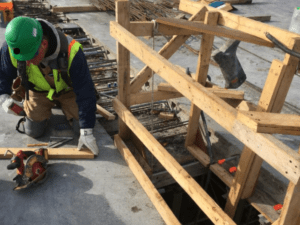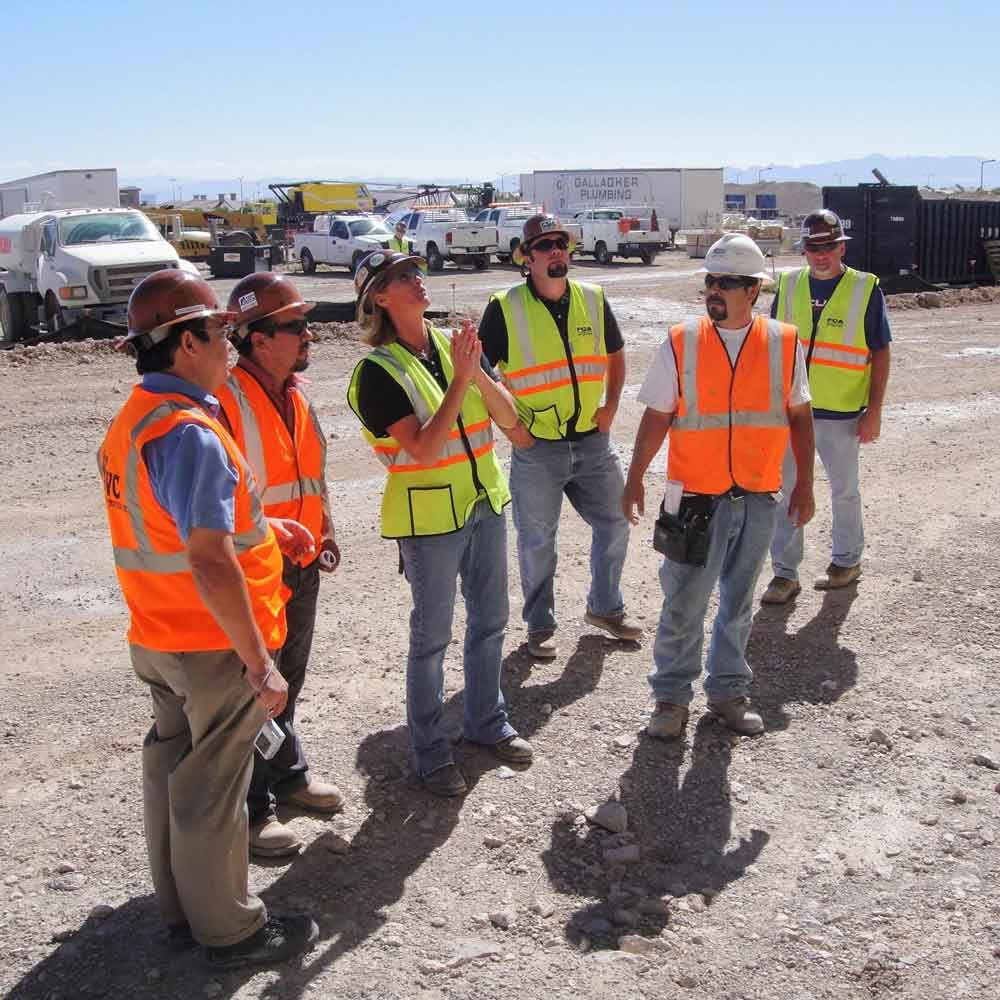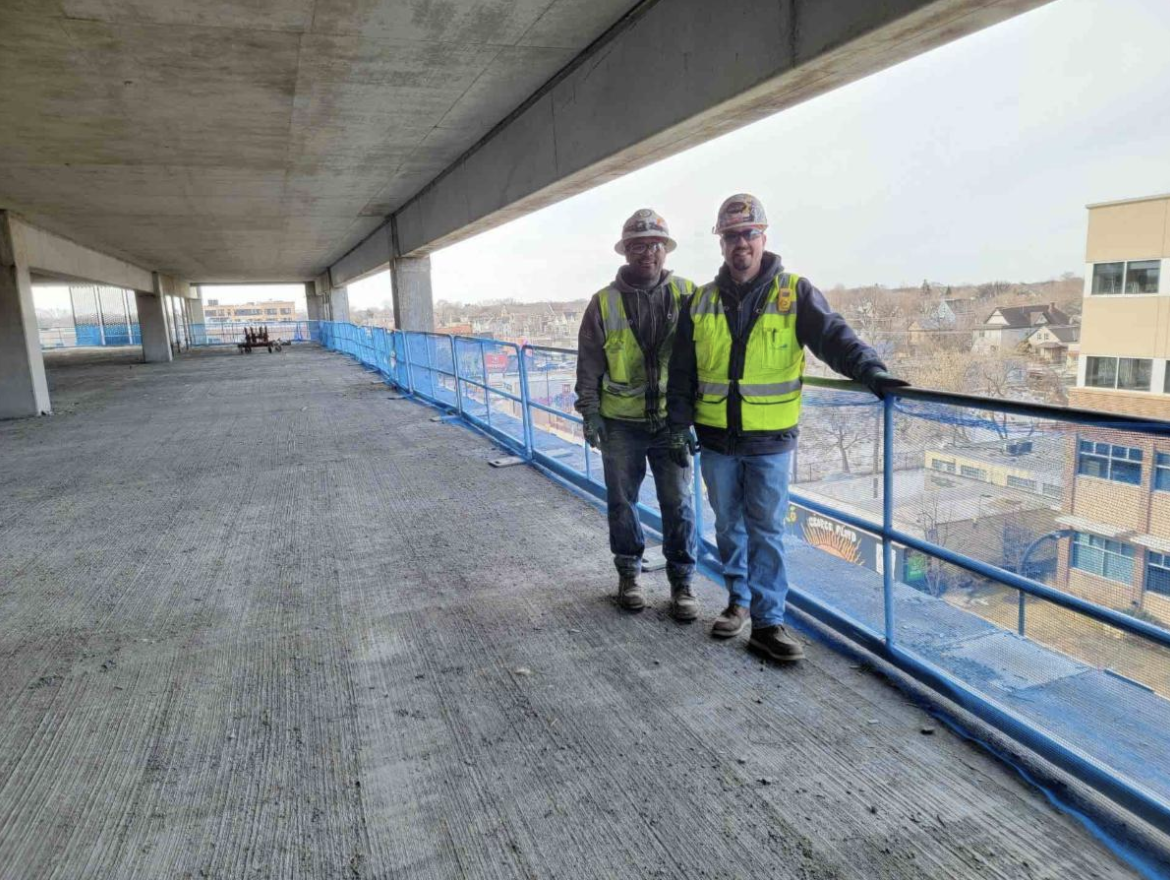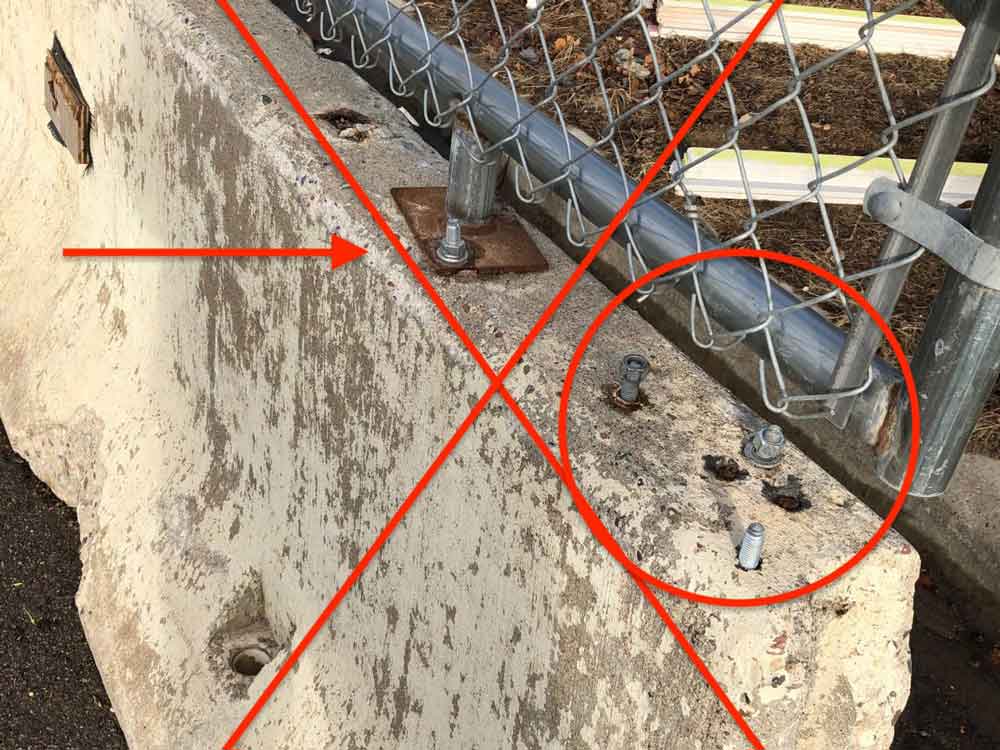Leading Edge Safety: Why Industry Leading General Contractors Are Turning Away From Job-Built Wooden Guardrails
 As the carpenter foreman completes his daily inspection of the wooden guardrail system, he notices a section where the toeboard is missing. A little farther down the line of the leading-edge safety guardrail, he notices a busted top rail. In a bit of disgust, he mutters,
As the carpenter foreman completes his daily inspection of the wooden guardrail system, he notices a section where the toeboard is missing. A little farther down the line of the leading-edge safety guardrail, he notices a busted top rail. In a bit of disgust, he mutters,
“What the heck, more maintenance issues with these wooden guardrails. Missing lumber and continually repairing damage means spending even more time and money on this project. These wooden rails are a pain in the @$$!”
This scenario plays out daily on construction sites. Like all industries, evolution is not only natural but necessary in order to stay competitive and compliant. It’s time for the construction industry to move from the wasteful and time-consuming wood guardrail system to a simpler and sustainable solution that supports leading-edge safety. Steel-engineered guardrail systems have been around for some time and have improved considerably in the last several years. One of the newest to come to market, the Hilmerson Safety Rail System™, launched two years ago and was designed in cooperation with industry-leading contractors for fast installation, low maintenance, cost savings, and leading-edge safety.
But with all the advantages that a fabricated steel guardrail system has to offer, like safer leading-edge safety, why do contractors continue to use wooden 2×4 guardrails? A great question, and one that Deb Hilmerson, President & CEO of Hilmerson Safety®, asked herself when she set out to design her innovative guardrail system:
“I think some of the apprehension for using an engineered guardrail for leading-edge safety comes from a lack of understanding of all the immediate benefits. And, implementing different and non-traditional processes on a large project can be intimidating”, says Hilmerson. She adds, “An engineered system is also more of an investment on the front end in comparison to wooden guardrails, but our customers are seeing the ROI is quickly realized.”
There are quite a few benefits of engineered leading-edge safety systems which include:
1. Avoidance of OSHA Citations
Broken or stolen wood components mean compliance challenges. Consistent uniform construction minimizes OSHA citations of metal guardrail sections and ensures that OSHA height and impact performance requirements for leading-edge safety are met. Lumber presents a greater opportunity for defect due to variability in grade quality and deterioration from exposure to the elements. An improperly constructed wood guardrail is considered “non-conforming” and subject to OSHA citations.
“The Hilmerson Safety Rail System™ alleviates human error during the installation process. Very simple to use: two bases, two pins, and a rail. Product design makes it easier to train new users and increases production on projects. Foremen will spend less time building guardrails and increase manpower in other areas.” – Russell Sadler, Messer
2. Less labor & Installation costs
When compared to wooden guardrail systems both free standing weighted (non-penetrating) and anchored (penetrating) steel guardrail systems install in a fraction of the time. A metal engineered guardrail is installed by two laborers or even non-skilled trade professionals whereas wooden systems require construction by carpenters. Skilled labor can be utilized elsewhere on project sites and not dedicated to building and erecting guardrails. Installation training is included at deployment. Installation is simplified with minimal components. Assembly times are greatly reduced utilizing an engineered guardrail system vs a wooden guardrail – with 120 linear feet being erected within 12 minutes (weighted base version) vs 27 minutes installing 120 feet of wooden guardrail.
“We were able to install, maintain and remove the Hilmerson Safety Rail System™ for about 60% less labor than our traditional handrail. Our biggest benefit is the low maintenance.” – Superintendent, Mortenson
3. Adaptability
With a steel guardrail system changing configurations to protect leading edges, holes, shafts, or other fall hazards is easily accomplished by moving whole sections and using smaller components for gaps. A penetrating and non-penetrating base option offers versatility and allow for applications for concrete construction, leading edges, and finished roofs. Expandable guardrail sections can be sized to fit intermediate lengths from 5 1/2 to 9 feet.
4. Sustainability
No more discarding guardrail lumber at the end of each project. With normal wear and tear the lifecycle of the Hilmerson Safety Rail System™ is 20+ years due to its sturdy 13-gauge galvanized steel construction. There is no excess material waste common to cutting lumber to length. Since rolling out the Hilmerson Safety Rail System™ in 2018, over 250,000 linear feet of 2×4 was saved from landfills.
5. Efficiency
Handling is easy and aided with the use of storage cart “kits” that can be moved via crane, fork truck, or wheeled by hand to the point of installation. A self-contained wheeled kit, consisting of a cart, 200 linear feet of guardrail, bases and all hardware needed to install the system, is quickly and effortlessly rolled to each guardrail installation location. Moving 70-pound weighted bases is facilitated with a wheeled dolly to reduce the strain of material handling.
On project completion, the guardrail system rapidly disassembles and stacks for storage. A leading-edge safety system that is unitized, with uniform components contained on a cart and shipping pallets/racks, can be quickly inspected and inventoried. Stackable carts reduce yard storage space and add to the ease of inventorying. Carts can be shipped side by side or double stacked on a trailer. The durability and benefits of being able to stack, store, inventory, and ship have become popular amenities for projects like the FC Cincinnati West End Stadium in Cincinnati, Ohio – a Turner Construction/Jostin Construction Joint Venture.
“The Hilmerson Safety Rail System™ is a clean and affordable solution to the age-old wooden guardrail,” said 25-year veteran, Superintendent, Bryan Popen of Turner Construction Company after installation at the FC Cincinnati West End Stadium. “This rail system is easy to install, adaptable, low-maintenance and also gives our job sites a professional appearance.”
6. Maintenance & Professional Appearance
With a steel guardrail system there is no painting needed, no rust, and minimal hardware for assembly – making it easy to inspect and maintain your leading-edge safety system. Re-work due to damage or replacement is infrequent. Add-on features of engineered systems such as debris netting can be efficiently installed using plastic reusable clips, therefore, eliminating the dangers of protruding nails and screws.
“These galvanized steel guardrails have virtually no maintenance, vs using a wood rail system, which helped reduce a lot of rework and constantly going back to adjust or move them. Super easy, light weight system and looks very professional!” – Safety Engineer, Mortenson
7. Return on Investment
The ROI is quickly appreciated in just a couple of projects and continues to return over its lifetime. A few of the benefits that make up the value proposition include no more wood waste, reduced installation time, reduced handling time, no sorting through and recycling lumber for the next project, minimal maintenance, and minimized exposure to enforcement actions. Made of hot-dipped 13g galvanized steel, The Hilmerson Safety Rail System™ kit can be reused for 20+ years on future projects with no added material costs. To combat the punishment of construction, scaffold-grade tube steel is used along with a hot-dipped galvanized application inside and out to prevent rusting.
8. Risk Reduction
No more wondering whether enough nails were used for construction of your leading-edge safety system. An engineered system means it has been designed and constructed to meet OSHA performance requirements. Engineered guardrail systems help combat injury, reduce risk, and provide leading-edge safety in the following ways:
- Use of lower consequence power tools in the form of a drill versus a pneumatic nail gun and circular saw to prepare and install components.
- Unitized delivery and movement via a wheeled cart to the point of installation minimizes lifting and carrying components.
- No nails or screws that present a cut or impalement hazard and wood splinters to dig out of hands.
- A manufactured engineered system always conforms to the OSHA guardrail performance requirements providing for a safer condition and lower risk of violation.
- The application of swing gates for secured access.
- An integrated toe board provides for falling object protection all the time and debris netting is easily installed using clips.
- Less time is spent at a leading edge installing an engineered safety rail versus a wood rail thus reducing exposure to fall.
If schedule, budget, margin, and safety are important to you then you are the type of contractor that needs to consider an engineered guardrail system. For more information email us or call (952) 239-0125.
About Hilmerson Safety
Hilmerson Safety® is a full-service safety product design and manufacturing company serving the construction industry. Since 2001 Hilmerson Safety® has been working with construction industry leaders and contractors to develop safe, lean, construction-grade™ products and solutions that add to the company’s bottom line.
For more information email us or call (952) 239-0125




